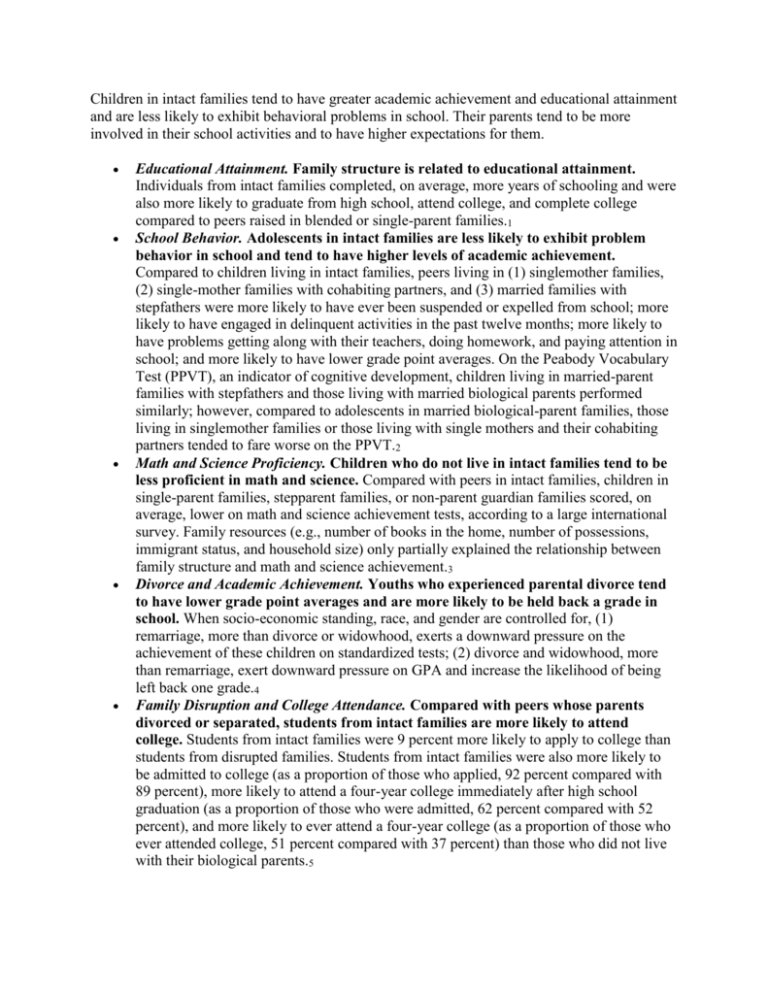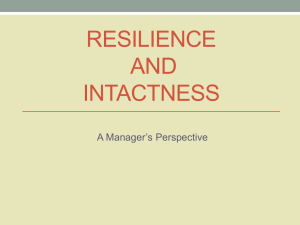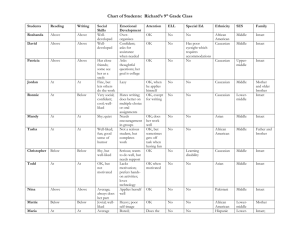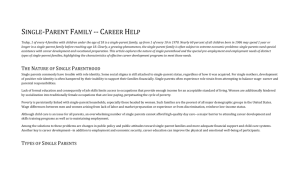Children in intact families
advertisement

Children in intact families tend to have greater academic achievement and educational attainment and are less likely to exhibit behavioral problems in school. Their parents tend to be more involved in their school activities and to have higher expectations for them. Educational Attainment. Family structure is related to educational attainment. Individuals from intact families completed, on average, more years of schooling and were also more likely to graduate from high school, attend college, and complete college compared to peers raised in blended or single-parent families.1 School Behavior. Adolescents in intact families are less likely to exhibit problem behavior in school and tend to have higher levels of academic achievement. Compared to children living in intact families, peers living in (1) singlemother families, (2) single-mother families with cohabiting partners, and (3) married families with stepfathers were more likely to have ever been suspended or expelled from school; more likely to have engaged in delinquent activities in the past twelve months; more likely to have problems getting along with their teachers, doing homework, and paying attention in school; and more likely to have lower grade point averages. On the Peabody Vocabulary Test (PPVT), an indicator of cognitive development, children living in married-parent families with stepfathers and those living with married biological parents performed similarly; however, compared to adolescents in married biological-parent families, those living in singlemother families or those living with single mothers and their cohabiting partners tended to fare worse on the PPVT.2 Math and Science Proficiency. Children who do not live in intact families tend to be less proficient in math and science. Compared with peers in intact families, children in single-parent families, stepparent families, or non-parent guardian families scored, on average, lower on math and science achievement tests, according to a large international survey. Family resources (e.g., number of books in the home, number of possessions, immigrant status, and household size) only partially explained the relationship between family structure and math and science achievement.3 Divorce and Academic Achievement. Youths who experienced parental divorce tend to have lower grade point averages and are more likely to be held back a grade in school. When socio-economic standing, race, and gender are controlled for, (1) remarriage, more than divorce or widowhood, exerts a downward pressure on the achievement of these children on standardized tests; (2) divorce and widowhood, more than remarriage, exert downward pressure on GPA and increase the likelihood of being left back one grade.4 Family Disruption and College Attendance. Compared with peers whose parents divorced or separated, students from intact families are more likely to attend college. Students from intact families were 9 percent more likely to apply to college than students from disrupted families. Students from intact families were also more likely to be admitted to college (as a proportion of those who applied, 92 percent compared with 89 percent), more likely to attend a four-year college immediately after high school graduation (as a proportion of those who were admitted, 62 percent compared with 52 percent), and more likely to ever attend a four-year college (as a proportion of those who ever attended college, 51 percent compared with 37 percent) than those who did not live with their biological parents.5 Special Needs Classes. On average, a greater proportion of children who are in specialeducation classes come from single-parent households. Children in specialeducation classes were more likely to come from single-parent households (58 percent) than from two-parent households (31 percent) and were somewhat more likely to be of an ethnic minority. Black children in special-education classes were the least likely to have intact families; 70 percent lived with a single parent while 16 percent lived with two parents.6 Preschoolers’ Cognitive Development. Family structure is related to preschool children’s verbal reasoning skills. Children of singlemothers had lower scores than children from twoparent families.7 Parental Marital Disruption and Academic Achievement. Parental divorce or separation is related to youths’ academic performance and educational expectations. Compared with their peers from intact families, students who had experienced parental marital disruptions scored lower on academic tests and had lower educational aspirations both before and after the disruptions.8 Parental Involvement in Education. Family structure was associated with parents’ educational expectations and involvement with their children’s schoolwork. Children of single or stepparents reported that their parents had lower educational expectations for them compared to reports from children in intact families. The former group also reported that their parents are less likely to monitor schoolwork and provide “less overall supervision of social activities” compared to reports from children in intact families.9 Divorce and School Attendance. Compared with peers in intact families, adolescents from divorced single-parent households tend to have greater levels of absenteeism, tardiness, and truancy in school. Parental divorce altered daily routines and work schedules while imposing additional demands on both adults and children living in single-parent households. Most adolescents had to assume extra domestic and childcare responsibilities; financial conditions required some adolescents to work part-time. These burdens resulted in children from singleparent households having greater levels of absenteeism, tardiness, and truancy in school.











